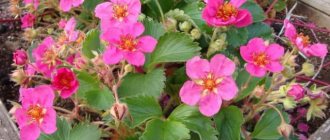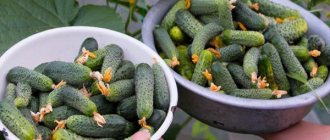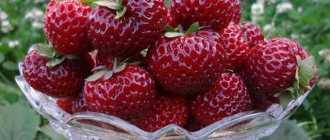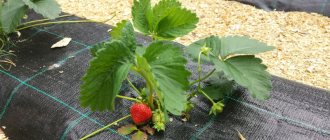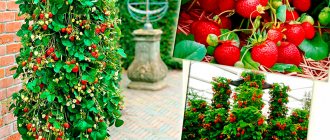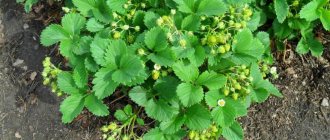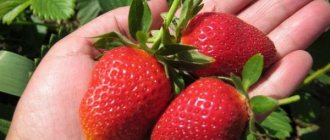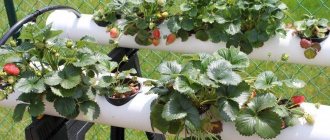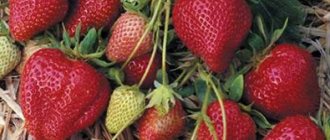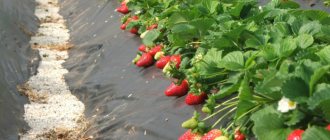Author: Natalya Category: Fruit and berry plants Published: January 27, 2017Republished: February 27, 2019Last edits: November 2, 2020
- When to plant
- Caring for remontant strawberries in spring
- Autumn pruning
- Reproduction by mustache
- Diseases and their treatment
- Varieties for the Moscow region
Remontability is the ability of plants to bear fruit repeatedly or repeatedly during one growing season. Repairability is observed in crops such as strawberries, wild strawberries, raspberries and some citrus fruits. In this article we will introduce you to the rules for growing remontant strawberries: how to plant and care for remontant strawberries at different times of the year, how to protect them from pests and diseases, how to propagate and how to prune remontant strawberries.
Planting and caring for remontant strawberries
- Planting: sowing seeds for seedlings in the middle zone - at the end of February or early March, in warmer areas - two to three weeks later. Planting seedlings in the ground - in the middle or at the end of May.
- Lighting: bright sunlight.
- Soil: leveled, loamy or sandy loam, neutral or slightly acidic reaction.
- Watering: after planting seedlings - daily, after rooting - once every 2-4 days. In dry spring conditions, the first watering of old bushes is carried out at the end of April, and in May and June another 3-4 waterings are carried out. From August to September, the area is watered 2 times a month, trying to wet the soil to a depth of 2-3 cm.
- Top dressing: in just one season, 10-15 top dressings with organic and mineral fertilizers are carried out from spring to late autumn. From organics, slurry and chicken manure solution are preferred, from mineral complexes - Kemira Lux, Kristallin or Rastvorin.
- Pruning: in the fall, carefully remove from the bushes those leaves that may be damaged by pests or infected with harmful plant microorganisms. In spring, remove old, overwintered leaves. The mustache can be trimmed at any time.
- Reproduction: by mustache, dividing the bush.
- Pests: aphids, wasps, strawberry mites, weevils, any beetles and their larvae, nematodes, ants, slugs and birds.
- Diseases: affected by gray rot, powdery mildew, white and brown spots and Fusarium wilt.
Read more about growing remontant strawberries below.
Varieties of remontant strawberry seeds
For many years now, strawberries have migrated from gardens and vegetable gardens to the window sills and loggias of ordinary apartments. Often at home they grow remontant garden strawberries, which are often called strawberries.
Remontability is the ability of a plant to bloom and bear fruit several times during the growing season. This way you can harvest from the beginning of summer until late autumn (until the first frost).
Today there are a large number of remontant varieties of strawberries on sale, so you can choose any one, relying on your taste preferences. It could be:
- large remontant hybrid strawberry (Scarlet Light, Sweet Tooth, Drop of Summer, etc.);
- “beardless” early ripening variety (Marmeladnaya, Alexandrina, Baron Solemacher, etc.);
- strawberries with berries of unusual color (hybrid - Golden Dessert, varieties - Snow White, Pineapple, etc.).
It is believed that the white variety of strawberries does not cause allergies, so this berry is given even to small children. Moreover, the vitamin composition is very similar to that of wild forest berries.
It is recommended to purchase seeds from trusted agricultural companies. There is another option - collecting seeds from the fruits of your own beds, but only after free pollination between several varieties will you be able to obtain a hybrid plant with special qualities.
Botanical description
Unlike ordinary strawberries, which lay fruit buds during short daylight hours, remontant varieties of the crop form them during long (LSD) or neutral (NSD) daylight hours. Remontant strawberries in open ground produce two harvests of berries per season - in July and in August-September, and the second harvest is much more abundant than the first - from 60 to 90% of the total number of fruits for the season. The problem is that not all bushes are able to withstand such a load, and many of them die after bearing fruit.
Landing
Features of growing remontant varieties:
- For planting, it is best to choose open, sunny areas;
- Fertile, well-loosened soil.
It is grown by pre-sowing seedlings. This is done in February or early March. In May, after the risk of late frosts disappears, the stronger seedlings can be planted in open ground.
Peculiarities! To get a good harvest, the land on the site needs to be prepared in the fall. Mineral and organic fertilizers are added to the soil and then dug deep.
Growing remontant strawberry seedlings
Sowing seedlings
You can purchase remontant strawberry seedlings at a nursery or garden pavilion, or you can buy seeds and grow seedlings from them yourself. However, growing remontant strawberries from seeds requires that the soil moisture for sowing should be in the range of 70-80%. To achieve this, you need to pour 700-800 ml of water into 1 kg of dry substrate (light humus soil or universal soil) and mix this composition thoroughly so that no lumps remain. Then containers with a diameter of 10-15 cm are filled with the moistened substrate, leaving 3 cm free to the edge.
Seeds of remontant strawberries are laid out on the surface of the substrate and sprinkled with a thin layer of dry substrate or sand, after which the crops are lightly sprayed with a fine spray, covered with film or glass and placed in a warm, bright place. Sowing is done in the middle zone at the end of February or beginning of March, and in warmer areas 2-3 weeks earlier.
- Cinquefoil: planting and growing, types and varieties
Growing strawberries from seeds - sowing seedlings
Seedling care
Until the seedlings appear, the soil with the crops is kept slightly moist. If the room temperature is maintained at 18-20 ºC, seedlings may appear within 10-15 days. As soon as this happens, transfer the containers with the sprouts to the windowsill of a well-lit window, and if this is difficult, provide the seedlings with additional lighting so that they do not stretch out. At this stage, seedlings need regular ventilation.
Picking remontant strawberries
In the development phase, the seedlings have 2-3 true leaves, that is, after about one and a half to two months, they are planted in spacious boxes or in separate pots. Transplant the seedlings to the same depth at which they grew before picking. And one and a half to two weeks before planting the seedlings in open ground, the seedlings are hardened: every day they are taken out for some time to the balcony, terrace or yard, gradually increasing the duration of the session. As soon as the seedlings adapt to external conditions, they can be planted in the garden.
How to properly collect seeds and prepare the soil for seedlings?
You can collect seeds of remontant strawberries exclusively from varietal bushes, and not from hybrid plants, since this is the only way to preserve the maternal qualities of strawberries. You should proceed according to this scheme:
- Choose ripe berries by picking them from a productive bush. It is necessary that it fully corresponds to the variety.
- Remove the top layer of skin with seeds using a sharp knife. Place on a plate and wait until completely dry.
- It is best to place the plate in a sunny place with good ventilation - this will allow the berries to dry quickly and not rot.
- After a couple of days, you can collect the seeds and leave the pulp in the bowl.
Seeds of large remontant strawberries on a saucer
Seedlings of remontant strawberries are grown at home, but in extremely rare cases they do this in the garden. The seedlings appear very small and at the same time tender, so in open ground they can easily die.
For strawberry seedlings, it is recommended to use ready-made universal soil with a neutral pH, which can be purchased at a specialty store. Usually it does not contain pathogenic microflora, and the composition of such soil is quite acceptable for growing berries.
To prepare the soil yourself, you should mix the following components:
- 0.5 kg of turf soil;
- 0.25 kg sand;
- 0.25 kg of peat.
It’s also good to add a little vermicompost and wood ash to this composition. After mixing, the soil is sent to an oven preheated to 100 degrees and heated for 2-3 hours. This is necessary to destroy weed seeds and insect larvae. Such soil should then be left for 3 weeks, adding beneficial bacteria to it, using the drug Siyanie or Baikal EM1.
Planting remontant strawberries
When to plant
It is better to grow remontant strawberries in an area where vegetables such as radishes, parsley, legumes, carrots, beets, garlic, calendula and mustard previously grew. And after crops such as potatoes, cucumbers, tomatoes, raspberries and cabbage, it is not recommended to grow remontant strawberries. Choose a site for strawberries that is sunny and level, where water will not stagnate. Soils preferable are loamy and sandy loam with a neutral or slightly acidic reaction. Sod-podzolic and peaty soil are not suitable for growing remontant strawberries.
Growing strawberries in the garden - planting and care
Seedlings are planted around mid-May or a little later, when the threat of return night frosts has passed. If you decide to plant remontant strawberry bushes before winter, then it is better to do this from mid-August to the end of September.
The soil for remontant strawberries must be prepared in advance: for spring planting - in the fall, and for autumn planting in the spring. Dig up the soil on the site with a pitchfork, clearing the future planting site of weeds and adding a bucket of humus, manure or compost and 5 kg of wood ash per m² to the soil. A month before planting seedlings, add 20 g of potassium sulfate and 40 g of superphosphate to the soil, or one tablespoon of the drug Kalijfos for each m² of area.
Spring planting
Seedlings of remontant strawberries are planted in two ways - carpet and row. With the carpet method, seedlings are planted according to a 20x20 cm pattern, and with the row method, a distance of 20-25 cm is maintained between seedlings in a row, and 70 cm between rows.
On a cloudy day, make holes in the area, water them and transfer the seedlings into them along with a lump of earth. You can plant two seedlings in one hole. When planting seedlings, make sure that the roots in the hole do not bend, and that the hearts are slightly above the surface of the area. Carefully squeeze the soil around the bushes so that there are no voids left in the roots, and water the strawberries.
Planting in autumn
If you plant remontant strawberries in the spring, their fruiting will most likely begin only a year later, and besides, not everywhere in mid-May the soil is already warm enough for heat-loving remontant varieties to immediately begin to grow and develop. Therefore, gardeners are increasingly resorting to autumn planting of remontant strawberries, especially since the technique for its implementation has been worked out to its subtleties.
Planting and caring for strawberries in autumn
Planting remontant strawberries in late summer or early autumn gives them time to take root and strengthen for winter without interference such as harmful insects and fungal pathogens. Remontant strawberries are planted in the ground in the fall in the same order as in the spring.
Preparing for planting
Strawberries are grown on fertile soil with a neutral composition. Good drainage must be ensured. It is best to plant plants on loamy soils. Heavy soil can be diluted with sand.
Remontant strawberries grow well in the soil after beans, radishes and parsley. The planting site is prepared in the fall - this will facilitate further care and cultivation. The land needs to be dug up, freed from weeds, enriched with phosphorus fertilizer and humus. The soil is left in this state for the winter.
Further preparation begins in the spring - two to three weeks before the upcoming planting. The soil is enriched with last year's manure (about ten liters per 1 m2). In May you can start planting.
If planting is carried out in the fall, the land must also be prepared. In this case, strawberries are planted from the third week of August until the onset of September. Such timing is considered the best, since the strawberries will not have time to take root before the first frost.
Growing remontant strawberries
Caring for remontant strawberries in spring
Caring for and growing remontant strawberries differs to some extent from cultivating ordinary garden strawberries. The berries of remontant varieties are large in size - some of them can reach a weight of 100 g, but such success is possible only if the conditions of the crop's agricultural technology are met.
After planting strawberries in spring, it is advisable to mulch the bed with straw, peat, pine needles, sawdust, or cover it with black agrofibre - this measure will allow moisture to remain in the soil longer, and it will be possible to water the strawberries less often. In general, caring for remontant strawberries includes watering them, carefully loosening the soil around the bushes, timely removal of weeds from the garden bed, regular fertilizing and protection from diseases and pests.
In early spring, old yellow leaves are removed from last year's remontant strawberries and ammonium nitrate is added to the soil. The next nitrogen fertilizing is applied at the end of May.
Remontant strawberries bear fruit for the first time in the spring, but it makes sense to sacrifice the spring harvest in order to collect more berries in the fall, especially since spring remontant berries are much inferior in taste to the fruits of ordinary garden strawberries. And if, in addition to remontant varieties, you also grow ordinary ones, enjoy their fruits in the spring, and remove the flower stalks of remontant strawberries as soon as they appear, and then the bushes will retain strength for abundant autumn fruiting and will give you berries of much higher taste.
- Strawberries: growing, planting and care
However, this technique is effective only for annual and biennial bushes. Although, if you take good care of your remontant strawberries and regularly fertilize them, you will be able to pick berries from them twice a season.
Summer strawberry care
How to care for remontant strawberries in the summer? After you harvest the first crop, you need to prepare the remontant strawberries for the second fruiting. To do this, you need to regularly fertilize, water and loosen the soil around the bushes. To enhance re-blooming, the leaves are cut off, being careful not to damage the apical bud. However, in some remontant varieties, fruits are also formed on the rosettes of the mustache, so it is better not to trim the leaves of such strawberries.
Remontant strawberries begin their second fruiting in the summer, in August.
How to care for autumn
Very often, after the second fruiting, it is necessary to plant new remontant bushes, since not every plant can withstand such a serious load. On average, with good care, a remontant strawberry bush lives and bears fruit for three years, but a lot depends not only on your efforts, but also on the climatic conditions of the area and the composition of the soil.
Watering
There is a special scheme for moistening beds with strawberries, since the crop has a shallow root system and cannot take moisture from the deep layers of the soil, while strawberry leaves intensively evaporate moisture. Remontant strawberries, like garden ones, are moistened regularly, but they need moisture even more than ordinary varieties, especially in extreme heat and during the fruiting period. Watering is carried out early in the morning or in the evening and only with warm water.
After planting, young bushes are watered daily for the first few days, and then switched to watering once every 2-4 days. For last year's bushes, the first spring watering, provided there is little natural precipitation, is carried out at the end of April. In May and June, you need to carry out another 3-4 waterings, and from August to September, remontant strawberries are watered at least twice a month. The soil in the beds should be moistened to a depth of 2-3 cm. The next day after watering or after rain, loosen the soil around the bushes to provide the strawberry roots with air and destroy the crust that forms on the surface.
We remind you that mulching the bed or covering the area with black agrofibre will allow you to spend less time and effort on watering, weeding and loosening the soil in beds with remontant strawberries.
Top dressing
Fertilizing remontant strawberries is one of the most important conditions for obtaining high yields and extending the life of plants, since they need a constant supply of potassium and nitrogen. NSD varieties are especially dependent on fertilizing. Phosphorus, if it was added in the required quantity before planting, will no longer need to be added to the soil this season; you can mulch the bed with humus, spending 2-3 kg per m², or with manure at the rate of 5-6 kg per the same unit of area .
Growing strawberries in the garden - planting and care
At the end of May, remontant strawberries are fertilized with a one to two percent urea solution, and approximately in the second half of June, during the extension of flower stalks of the second harvest, the beds can be watered with a solution of chicken manure or slurry, for which a bucket of manure is diluted with 8-10 parts of water, and a bucket of concentrated slurry - 3-4 parts.
In total, from 10 to 15 complex feedings are carried out per season. Fertilize remontant strawberries until late autumn, while their roots are growing, otherwise they will retire weakened and exhausted. For fertilizing, not only organic, but also mineral fertilizers are used, for example, Mortar, Kemiru Lux or Kristallin.
Transplanting remontant strawberries
Actually, there is no point in replanting remontant strawberry bushes, since they are short-lived and usually last no more than three to four years, even with very good care. And we will tell you how to transplant the resulting daughter rosettes in the section on the propagation of remontant varieties.
But if you still have a need to replant strawberry bushes, you should understand that in the fall this is done no later than three weeks before frost. Transplanting remontant strawberries in the spring will deprive you of the opportunity to get a quick harvest, so replant them as early as possible, before flower stalks appear, and then you will be able to get the first berries after mid-July. If flower stalks have already appeared, you will have to remove them to allow the strawberries to spend energy on successful rooting and adaptation, and not on flowering.
Secrets of growing delicious strawberries
In order for growing strawberries to be a pleasure, the harvest to be high and tasty, it is worth knowing some subtleties. Below are a few secrets that can help you achieve success.
- Purchasing certified virus-free strawberry seedlings. Healthy plants are the key to successful strawberry growing.
- Predecessors. Avoid planting strawberries in areas where potatoes, tomatoes and strawberries have recently been grown.
- You need to provide plenty of sunlight. Find a sunny place. Heat and light help produce sweet and tasty berries.
- Fertile and permeable soil. It is better to plant strawberries in slightly acidic soil 6 -6.5 pH. About a month before planting, mix the soil with compost or manure. Pelleted manure (easy to use, natural, safe and odorless) is also a great solution.
- Agrotextiles against weeds. Don't let weeds compete with your strawberries. Black agrotextiles naturally prevent the development of weeds, while simultaneously allowing water and air to pass through, retaining moisture in the soil. Strengthens the root system and speeds up the growing season. An additional advantage of using agrotextiles is the collection of clean and unsorted berries. It is worth additionally during the flowering season to spread straw under the plant, which will reflect the sun's rays and the fruits will not ripen so quickly.
- Space. Plant the seedlings at a distance of about 30 centimeters, the distance between rows is 50 centimeters. Strawberry roots should not curl. Be careful not to plant the strawberries too shallow so the roots dry out or too deep.
- Pick ripe berries on a sunny day. To keep strawberries fresh and firm longer, pick the fruit together with a stem at least 1 cm long.
- Replace old plants every 3-4 years. Strawberries will become unproductive after this time. It is best to replace them with new ones that are free from disease and pests.
Pruning remontant strawberries
Autumn pruning
After the end of autumn fruiting, you need to carefully remove the leaves from the bushes, trying not to damage the axils of the upper leaves, since it is in them that the plant lays next year’s fruit buds. Leaves are removed in order to get rid of possible infections and pests - only mature healthy shoots will remain for the winter. Pruning of remontant strawberries should be completed with preventive treatment of the area against diseases and pests.
As for the mustache, you can trim it throughout the season, or you can not trim it at all. Some gardeners believe that they should be pruned so that the plantings do not become overgrown, but others argue that some varieties of remontant strawberries bear fruit on daughter rosettes that grow on the mustache, so you cannot trim the mustache, and to prevent the plantings from becoming overgrown, you just need to plant the bushes at a considerable distance from each other. However, on the eve of winter, if you are planning to trim the leaves of remontant strawberries, you should also trim the mustache.
- Hawthorn: growing in the garden, properties, types
How to prune in spring
In the spring, old, yellow, overwintered leaves are trimmed from strawberry bushes, if you did not trim them the previous fall, after which the remontant strawberries are treated against diseases and pests. And it must be said that many gardeners prefer to prune remontant strawberries in the spring.
Remontant strawberries care and cultivation in Siberia
The main problems of growing crops in Siberia are freezing in winter and damage to young seedlings by spring frosts. Breeders help cope with this problem by creating frost-resistant species. Requirements for soil and growing areas are similar to warmer regions. The main point is the availability of sunlight, which in cold regions is sufficient during the summer season. It is important to place the beds away from buildings and trees.
An additional problem for growing in Siberia is the high snow cover. On cold winter nights it protects the plant from frost, but during the spring thaw it provides too much moisture, sometimes even washing out the beds.
A variety with fast growing season was bred especially for the northern territories. After all, in a short period of time, the plant must have time to organize itself, produce a harvest, and lay fruit buds for the next season. Such varieties require more serious care.
The following species have been bred for the territory of Siberia:
- "Berdskaya". It has a sweet and sour taste. The northern regions germinate under film.
- "Russian Darenka". A fairly productive species, adapted to sudden changes in temperature. Shows resistance to pests and fungal infections.
- "Amulet". Has the ability to produce up to 2 kg of yield per bush. It is practically disease-resistant and survives winter frosts well. The berries have a rich sweet taste.
- "Omsk early". The species was bred specifically for Siberia. The fruits are sweet and small in size, great for making jam and compotes.
- "Chamomile". It bears large, sweet fruits that can withstand transportation well.
For your information! In areas with harsh climatic conditions, it is recommended to plant several varieties with different fruiting periods. If spring frosts injure early varieties, bushes with later fruiting will bear fruit.
Propagation of remontant strawberries
We have already described the propagation of remontant strawberries by seed seedlings. How else can you propagate this type of strawberry?
Reproduction by mustache
If you want to expand your remontant strawberry bed with rooted runners, you'll have to sacrifice a second crop. During the first fruiting, mark the strongest and most developed annual bushes, place their first tendrils in grooves made along the side of the bed, and the remaining tendrils will have to be cut off so that they do not weaken the mother bush. After a while, sprouts will begin to appear on the mustache, but you will only need to leave the first rosettes. Trim the second-order tendrils, but do not separate the first rosettes from the mother plant.
While they are gaining volume and strength, water and weed the soil around them. A week before transplanting the rosettes to a permanent place, separate them from the mother plant, and then replant them as described at the beginning of the article.
Dividing the bush
This method of propagating remontant strawberries is used when there is not enough planting material. Divide into developed bushes of two, three and four years of age with strong roots - by this age the bush has already formed many shoots-horns, each of which has a rosette of leaves. Such a bush is dug up in early spring or autumn, carefully divided into horns, and then planted in a garden bed.
Reproduction
Strawberries can be propagated by tendrils, dividing the bush or seeds. In the latter case, seedlings are grown at home. Seeds are sown in small greenhouses in February to ensure the seedlings are strong and ready for planting in the spring. This method requires special training and sufficient time.
The simplest option is propagation by means of a mustache. This method does not require much experience or skill, provided that the strawberry has a sufficient number of tendrils. If there are few of them and there are no seeds, you can propagate the crop by dividing adult bushes.
Remontant strawberries in winter
With the onset of autumn, watering the strawberries is gradually reduced, they undergo sanitary pruning, if there is confidence that remontant strawberries should be pruned in the fall, they carry out preventive treatment against diseases and pests, after which they allow the remontant strawberries to survive a couple of frosts and only after that they cover them with non-woven fabric for the winter material, although where winters are short and mild, sawdust, fallen leaves, hay or straw can be used as shelter. Old bushes that are unlikely to bear fruit next season need to be dug up before the first snow.
How to care for strawberries after fruiting
How to grow a remontant variety
Remontant strawberries can be grown in several ways:
- from seeds;
- dividing the bush;
- rooting the mustache.
Each method has its own strengths and weaknesses. So, for example, sowing seeds for seedlings is much cheaper than buying ready-made seedlings from a nursery, but this is a troublesome task. At the same time, not all varieties of remontant strawberries have mustaches; there are many without mustache varieties of sweet berries. You can divide the bushes only if they are healthy and full of vigor, which, as mentioned above, is rather rare for remontant varieties.
Therefore, each gardener must independently determine for himself the most appropriate way to grow berries. Strawberries can be planted both in spring and autumn; remontant varieties tolerate winter cold well.
Attention! When planting strawberries in the spring, you should not expect a harvest in the same season.
Therefore, most gardeners prefer to plant seedlings in the ground in September, then the bushes will have a couple of weeks to take root, and next year they will already bear sweet berries.
Seedling growing method
In this case, the gardener must purchase or collect strawberry seeds himself, and then plant them in the same way as the seeds of vegetable crops, such as tomatoes, peppers or eggplants.
The berry loves nutritious and loose soil; it is better to prepare the soil for seedlings in advance. For these purposes, experienced gardeners recommend taking soil from the area of the garden where vegetables grew last season, but turf garden soil is not suitable for seedlings.
The soil should be slightly acidic or neutral. Seeds will germinate only if the soil moisture is at least 70%. Such conditions can be ensured if at least 0.7 liters of water are poured into a kilogram of purchased substrate or soil mixed with humus. The soil is thoroughly mixed so that there are no lumps and placed in prepared containers for seedlings.
Leave about 3 cm from the top of the cups or boxes; the rest of the container is filled with substrate. The seeds of remontant strawberries are evenly spread over the surface of the soil, then they are carefully sprinkled with a thin layer of dry earth or river sand. All that remains is to water the seeds; for this, use a spray bottle.
Now the containers are covered with glass or film and placed in a warm place with a constant temperature of 18-21 degrees.
After 14-20 days, the strawberry seeds should hatch and the first shoots will appear. Then the film is removed, the seedlings are carefully watered and placed on a windowsill or other place with sufficient sunlight.
Attention! Since remontant strawberry seeds are usually sown at the end of February, natural light may not be enough for the normal development of seedlings. In this case, use phytolamps or simply illuminate the seedlings with ordinary lamps.
When the plants have two or three true leaves, and this period begins no earlier than 1.5-2 months after sowing the seeds, the seedlings of the remontant crop need to be plucked. Plants can be replanted either in individual containers or in spacious wooden boxes. Those who grow strawberries at home can plant seedlings into permanent pots.
Strawberries need to be picked in the same way as vegetables: the plants are carefully transferred together with a lump of earth between the roots. Seedlings should be buried at the same level as they grew before. Now all that remains is to water the seedlings and monitor their development.
Strawberries must be hardened 10-14 days before transplanting into open ground. The pots are simply taken out into the fresh air, gradually increasing their time there. Now the seedlings are completely ready for planting in a permanent place!
Propagation of remontant strawberries by mustache
With the help of mustaches you can both grow individual young bushes and expand the mother bush. In any case, the antennae should first be rooted. Only the first mustache is suitable for these purposes; the remaining branches will have to be removed.
Important! To root the tendrils of remontant strawberries, you will have to sacrifice the second harvest of this berry.
In August, all flowers from the bushes should be removed, otherwise the plant will die, since it will not have enough strength to ripen the crop and root the shoots.
During the period of first fruiting, the gardener must examine the young bushes and determine the strongest and healthiest of them. A shallow groove is made along the edge of the bed, into which the first mustache is laid.
After a few days, shoots will begin to appear on the tendrils; do not leave all of them—the shoots are removed, except for the first two or three rosettes. Young rosettes should not be immediately separated from the mother bush, let them gain strength and power. The shoots are watered together with the old strawberry bushes and the soil around them is loosened.
Approximately 7-10 days before the intended transplantation of the shoots, they are carefully separated from the mother bush by cutting the tendrils. Now the seedlings are ready for planting in a permanent place.
Dividing a remontant strawberry bush
Remontant bushes are divided infrequently, since they are already greatly weakened by prolonged fruiting. But, when there is not enough planting material in the new season, it is quite possible to resort to this method.
First you need to select the most expanded and strong plants - usually two to four-year-old bushes with a well-developed root system are chosen. At this age, strawberries, as a rule, have several branched horns, on each of which a rosette of new leaves is formed.
At the beginning of spring, such a powerful bush should be dug up and carefully divided into rosette horns. Each seedling is planted separately in new beds.
Pests and diseases of remontant strawberries
Diseases and their treatment
Remontant strawberries suffer from the same diseases as ordinary garden ones: gray rot, powdery mildew, white and brown spots and fusarium wilt.
Strawberry pests and diseases - control methods
Pests and their control
The pests most often affecting remontant strawberries are aphids, wasps, strawberry mites, weevils, beetles and their larvae, nematodes, ants, slugs and birds. Diseases and pests of remontant strawberries, as well as methods for getting rid of them, are described in detail in the article already posted on our website.
Basic techniques for caring for DSD varieties
How to grow remontant strawberries? There are general care rules that are typical for any strawberry crops, but there are also some peculiarities.
Loosening the soil should be carried out regularly, especially after watering or rain. Loosening is necessary to provide air access to the roots of the plants. This technique is carried out carefully: you must not damage the root system or newly rooted mustache (if you need to preserve it). When mulching, loosening is not necessary: the soil under the mulch layer remains moist and loose.
When caring for remontant strawberries, watering with warm, settled water is very important. This care is especially important during the period of fruit ripening, when the climate is very hot. The soil should not dry out, and moisture should be kept 2-3 cm deep, otherwise the berries will be small or begin to crumble. If the surface is covered with mulch, then such frequent watering is not necessary.
It is most convenient to fertilize during watering. To do this, grind the herbs of wormwood, yarrow and nettle, add water and leave for 7 days until the composition ferments. This is good nutrition during the period of growing and caring for remontant strawberries, as it contains a set of microelements necessary for the plant. An infusion of bird droppings (1:15) or an infusion of mullein (1:10) is useful.
Caring for remontant strawberries also includes removing the mustache. There are varieties that produce almost no mustache, while others produce a lot of them. They weaken the bush, reduce the yield, and do not allow the plant to grow stronger.
During the growing season, gardeners regularly remove excess shoots. If necessary, leave 1-2 strong young specimens from the mother plant to renew the plantation next year. Reddening leaves are also removed, which helps rejuvenate the bush during cultivation and is one of the techniques for caring for a remontant crop.
Advice! Since plantings are renewed every 2 years, the strawberry bushes should be placed freely so that there is room for the growth of mustaches that will replace the mother plant.
During cultivation, remontant strawberries are not spared by pests and diseases. Most often the berry crop gets sick
- gray rot, which is a fungal infection and “attacks” bushes in cool and humid weather;
- powdery mildew, similar to a white coating in the form of a cobweb and also related to fungal “misfortunes”;
- brown spot is a fungal disease that affects old leaves, on which bright brown spots are clearly visible.
If signs of the disease are noticed, the infected foliage or berries are removed and, if necessary, treated with chemicals. Of the pests, strawberries most often suffer from the strawberry mite, which is removed with a Karbofos solution after harvesting.
Warning: Insecticides should not be applied to flowering plants.
The first treatment occurs during the formation of young foliage, the second is carried out during the formation of inflorescences, and the third is possible after harvesting. The drugs need to be changed, since both pests and microorganisms can get used to them.
When growing DSD varieties in open ground, the second harvest does not always have time to “give off the berries” in full. Cold weather sets in and the fruit-bearing plant goes under the snow with berries. The plants remain unprepared for winter, and it is no longer possible to collect the crop remaining on the branches.
In the northern regions, remontant strawberries are grown in protected soil (under a film), so the first fruiting occurs earlier and the second wave of berries has time to ripen. This type of care is called “growing in tunnels,” when in August a breathable covering material is stretched over the beds using arcs. Due to the heat, fruiting extends until October.
How to prepare berries for winter
How to care for remontant strawberries before the onset of cold weather? Autumn care and care for red berries in the fall are no less important than during the growing season. The following activities are carried out:
- Plants that are tired over the summer period need to be fed using complex fertilizers. This will give the bushes strength for spring growth and make subsequent care easier.
- At the end of summer, all peduncles of remontant strawberries are pruned. Before the onset of cold weather, the berries do not ripen, and the plant uses forces to form them.
- Before frost, the soil around the holes is loosened, mixed with a mulch layer. Then sprinkle a fresh layer of mulch on top: rotted leaves, humus, sawdust.
- After the onset of cold weather, remontant strawberries are pruned, during which the leaves are completely removed, leaving the petioles at a height of 2 cm from the soil surface.
- During the same period, the plantation is covered for the winter with spruce branches, leaves, and mown grass. This is an important point in care, which allows the remontant bushes and roots not to freeze in the cold.
Such preparation methods relate to the peculiarities of growing remontant strawberries. They will help the berry crop survive the winter and begin the second season in the spring with renewed vigor. During the spring, the berry crop will grow, become stronger and be able to once again please its owners with a harvest of aromatic berries.
Growing, caring for, and pruning remontant strawberries in the fall can be seen in the video:
Varieties of remontant strawberries
As already mentioned, varieties of remontant strawberries come in two types - NSD (neutral daylight hours) and DSD (long daylight hours). The former bear fruit continuously, while the latter produce two or three harvests per season. In addition, remontant varieties are divided into those that form mustaches and those that do not form them, as well as small-fruited and large-fruited. We offer you a description of varieties of remontant strawberries for growing in warm regions, in the middle zone and Siberia.
Varieties for the Moscow region
The best varieties of remontant strawberries for the Moscow region:
- Aromas is a highly productive variety, resistant to powdery mildew and strawberry mite with large, dense, shiny berries of high taste;
- Vima Rina is a Dutch day-neutral variety that produces almost no runners, begins bearing fruit in the second half of June and stops forming fruits with the first frost. The berries of this variety are dark red in color, large - weighing up to 75 g, not very dense in consistency, with high taste;
- hybrid Tristan is a compact early-flowering variety that hardly forms a mustache and bears fruit throughout the summer with sweet berries of dark red color and medium size. The flowers of this variety are large, juicy pink;
- Garland is one of the best remontant varieties, which has no equal in terms of productivity. In addition, it is highly decorative, since on the bush you can simultaneously see flowers, ovaries, and red sweet fruits weighing about 40 g. Strawberries of this variety are grown both in beds and in vertical cultivation;
- Diamant is an American highly productive variety with the best taste characteristics to date. Diamond fruits are dense, large - up to 50 g in weight, shiny, dark red in color. Since the pulp of the berries is light, it is not used for processing. Bushes of this variety are capable of forming mustaches, which greatly facilitates its propagation.
In addition to those described, remontant strawberries for the Moscow region have proven themselves well in the varieties Cascade, Cardinal, Queen Elizabeth 2, Ostara, Sweet Evi, Evis Delight, Evi 2, Elsanta, Selva, Figaro, Florin, Floriant, Everest, hybrids Merlan, Pican, Roman and others .
Varieties for Siberia
In the harsh Siberian climate, it is not easy to grow heat-loving plants, and not every strawberry variety can fully develop and bear fruit in such conditions. However, there are varieties that can be grown here: they produce the first harvest together with ordinary garden strawberries, and in order to wait for the second harvest, you will have to use film to cover the beds. The best varieties for Siberia are:
- Queen Elizabeth 2 is a winter-hardy variety with early fruiting, the berries of which are bright red, excellent taste, with dense pulp, sometimes reaching a weight of 100-110 g;
- Mount Everest is an unpretentious variety in terms of soil composition, resistant to diseases and pests, with powerful, densely leafy bushes, tall peduncles and bright red small berries of a conical shape and good taste. This variety forms mustache only in the first year of growth;
- Inexhaustible - a large-fruited, productive variety, bred by crossing the Inexhaustible and Upper Silesia varieties and forming medium-height, slightly spreading bushes with large dark green foliage, on which large, blunt-pointed shiny berries of excellent taste ripen. The pulp of the berries of this variety is light pink. The variety produces few whiskers and is also susceptible to powdery mildew;
- Russian size is a large-fruited hybrid variety, resistant to frost and disease, with juicy berries of excellent taste;
- Ada is a high-yielding variety of German selection, capable of forming a large number of mustaches. The berries are bright red, medium in size, shiny, elongated-conical, with an average weight of 5-6 g. The pulp is white with a red core, loose, with a pleasant sour-sweet taste. The disadvantage of the variety is its instability to strawberry mite and white leaf spot;
- Primadonna is also a hybrid variety with powerful bushes, tall peduncles and bright red sweet berries.
The best varieties of remontant strawberries
In order to determine which variety of remontant strawberries is better than others, you need to be aware of what you expect from it. Some gardeners are more interested in the size of the berries, others - the taste, and still others - the ability to form mustaches, because it is desirable to be able to propagate the variety you like. We offer you a description of the different varieties, and you decide for yourself which one you need. So, the best remontant strawberries:
- Brighton is a beardless NSD variety bred by American breeders. In protected ground conditions, this strawberry bears fruit for up to 10 months a year, and in open ground - from spring to late autumn. The fruits of this variety, red, shiny, sweet and sour in taste, reach a weight of 50 g. During cold weather they become larger and elongated. The variety is distinguished by its cold resistance, as well as resistance to diseases and pests;
- Crimean remontantnaya is one of the best DSD varieties of Ukrainian selection - high-yielding, continuously bearing fruit from the end of May to October. The berries of this variety are smooth, juicy, large, dark red in color, with the aroma of wild strawberries. The advantages of the variety are also high decorativeness, winter hardiness, resistance to strawberry mites and diseases. The harvest is formed both on bushes and on rosettes;
- Autumn Fun is one of the first DSD varieties of Soviet selection, bearing fruit twice a season. The juicy fruits of this variety weigh 20 g, have dense pulp and an excellent dessert taste. The variety produces mustaches and is resistant to nematodes, strawberry mites and fungal diseases;
- Roman is a hybrid variety of NSD, which differs from others in its high decorativeness due to pink flowers on long peduncles that stand out effectively against the background of lush green leaves. Strawberries bear fruit in protected soil with proper care for up to 10 months a year. The fruits are smooth, weighing up to 25 g, excellent taste and pleasant aroma;
- San Rival is a French variety of medium yield. The first berries of the harvest are irregularly shaped, ribbed, comb-shaped. Subsequently, the fruits develop of medium size, round, without a neck, shiny and pubescent. The taste of the berries is sweet and sour, the pulp is juicy and tender. The advantage of the variety is also the ability to form a large number of whiskers, which greatly facilitates the cultivation of strawberries;
- Selva is an American variety bred by crossing the Brighton, Pajero and Tufts varieties. The bushes are vigorous, with large leaves, but compact. The berries are large, light red, elastic, shiny, cone-shaped, with dense juicy pulp, but have a rustic taste and inexpressive aroma. The variety is resistant to diseases of roots and leaves, but is not frost-resistant;
- Herzberg Triumph is a winter-hardy variety that forms many mustaches, bred by German breeders, with dark red, shiny truncated-conical small berries weighing up to 6.5 g with dense, but tender and juicy pulp with a sweet taste. The disadvantage of the variety is instability to angular and white spots;
- Yellow miracle is a beardless variety for lovers of oddities. This is a disease- and pest-resistant yellow remontant strawberry with medium-sized fruits weighing up to 3 g, elongated-conical in shape, growing on compact bushes up to 25 cm high. The variety is not particularly fragrant.
New varieties of remontant strawberries
Recently, breeders have developed new varieties and hybrids of remontant strawberries that may be of interest to gardeners. For example:
- Albion is a Californian variety resistant to weather stress, anthracnose, late blight, rot and wilt with dark red, large shiny conical fruits, a unique strong aroma and intense sweet taste. The fruits ripen well to the very tip. Young leaves have a strong shine;
- Gigantella Maxi is a Dutch variety with very large berries, weighing 100 g;
- Korona is also a Dutch variety with aromatic red fruits of excellent taste that tolerate transportation well;
- Kimberly - a variety with sweet red berries that taste like caramel;
- Galya Chiv - a new highly productive Italian large-fruited variety - the average weight of bright red fruits, characterized by high sugar content, is 45 g;
- Lyubava (or Lyubasha) is an unpretentious, high-yielding and most winter-hardy of all remontant varieties with small dark red oval-rhombic berries weighing 20-30 g, which have an intense taste and aroma. This strawberry produces berries both on bushes and on rosettes, so it is used for vertical growing;
- Portola is a high-yielding variety bred in 2009 in California. Its large, shiny, regularly conical-shaped fruits are similar to Albion berries, but slightly lighter and have a more harmonious taste, practically devoid of acid. Fruit weight is about 30 g. The variety can be grown both in protected and open ground. The disadvantages of the variety are instability to fungal and viral diseases;
- San Andreas is one of the newest varieties of NSD, characterized by high yield, resistance to spotting and other diseases, as well as pests. The bushes of this variety are powerful, the berries are bright red, large, weighing up to 30 g, shiny, also reminiscent of the fruits of the Albion variety. The pulp of the berries is juicy, fleshy, sweet, and of high taste.
Types of remontant strawberries and their features
Garden strawberries come in two types:
- small-fruited remontant strawberries, reminiscent of wild strawberries, which is the main character of this article;
- large-fruited remontant strawberry, which is usually called strawberry.
A small digression to clarify terminology. What we are accustomed to calling strawberries, from a scientific point of view, is not a strawberry at all, but an ordinary large-fruited garden strawberry. But since childhood, I have become accustomed to the fact that large berries are strawberries, and small ones are strawberries. And I’m not the only one, because most people divide them this way. It's easier to say one word than three.
This crop originated from wild strawberries and inherited the size and taste of the berries. Remontant strawberries have a variety of colors (white, yellow, cream, dark red).
Remontant strawberries are distinguished by a long and continuous period of fruiting, lasting from June to September-October (until frost). Among the variety of varieties there are beardless ones, which are especially popular, and varieties that form a mustache.
Pruning bushes in autumn and preparing plants for winter
In the fall, after the end of the fruiting period, strawberries are pruned. Foliage, tendrils and rosettes rob the plant of the strength it needs to accumulate for the next flowering. Therefore, if you want to get a good harvest next year, this procedure is necessary.
You need to trim the leaves immediately after harvesting the last harvest, so that by winter the bushes have time to acquire fresh leaves , which will act as a natural heat insulator. If you missed the moment and new leaves do not have time to grow before the onset of cold weather, it is better to leave the old foliage and cancel the pruning.
Pruning leaves of remontant strawberries in autumn
Leaves and tendrils are cut off at the very base so that their remains do not harbor harmful insects. Send the trimmed parts of the plant to the compost pit, just carefully inspect them for the presence of pests or diseases; perhaps they should be burned.
After pruning, the plantings need to be treated with insecticides as a preventive measure. And so that new foliage has time to grow before winter, the plants must be watered regularly. You can also feed the roots with organic fertilizers.
In the central and northern regions, the beds are insulated for the winter with a layer of manure or fallen leaves, at least 5 cm thick. But the best protection from the cold for strawberries is snow . To make its layer thicker, place tree branches between the beds. They retain snow well and form high snowdrifts.
These are the main points regarding the cultivation of remontant strawberries. After studying them, all that remains is to choose specific varieties for yourself, of which, at the moment, a lot has been bred.
Basic techniques for caring for NSD varieties
Caring for remontant strawberries of NSD varieties has its own characteristics. Let's start with the fact that the bushes will have to be replaced annually; they are not able to bear fruit for years. Since it produces berries throughout the entire season from spring to autumn, the bush ages quickly. And the next year, an inexperienced gardener, when growing a remontant variety, will find small berries on the bushes of the second year, which is not related to care.
Therefore, it is worth considering another option on how to care for remontant strawberries NSD:
- in August, young plants of a certain variety (or several varieties as desired) are planted: before winter they will take root well and become stronger;
- after planting, if there are flowers or ovaries on the bushes, they should be removed, which will ensure next year’s harvest;
- The remontant crop bears fruit from May until frost, so fresh berries will be on the table throughout the growing season;
- in August, shoots are taken from each mother bush and a new berry plantation is created;
- old plants are removed after the fruiting period ends (on the eve of frost);
- young bushes are mulched and covered with straw, spruce branches, and leaves on top to make wintering comfortable.
Important! Never leave bare soil under strawberry bushes.
It is necessary that the soil is mulched. For the winter, you can cover it with green manure grown over the summer, which is another care technique.
Productive and cost-effective cultivation of remontant strawberries is possible with timely care, pruning, mulching, and preparation for winter.
